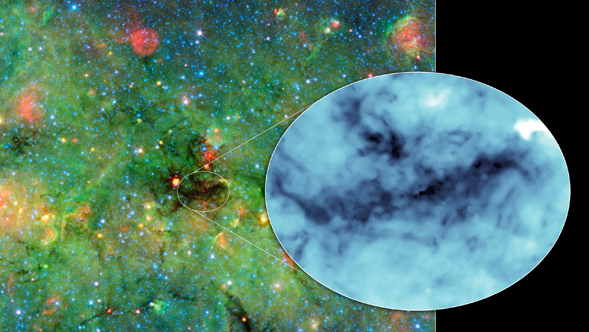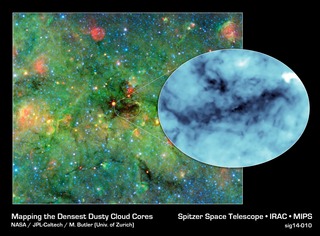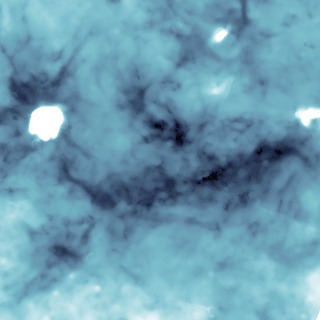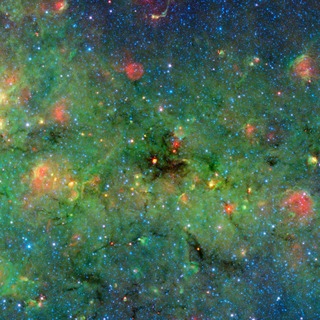
Observation • May 21st, 2014 • sig14-010
sig14-010
Astronomers have found cosmic clumps so dark, dense and dusty that they throw the deepest shadows ever recorded. The clumps were discovered within a huge cosmic cloud of gas and dust. Infrared observations from NASA's Spitzer Space Telescope of these blackest-of-black regions in the cloud paradoxically light the way to understanding how the brightest stars form.
The large cloud looms in the center of this image of the galactic plane from Spitzer. The zoom oval to the right shows details of the cloud, revealing the dense clumps. A new study takes advantage of the shadows cast by these dark clumps to measure the cloud's overall structure and mass. These dense, clumpy pockets of star-forming material within the cloud are so thick with dust that they scatter and block not only visible light, but almost all background infrared light as well.
The dusty cloud, the results suggest, will likely evolve into one of the most massive young clusters of stars in our galaxy. The densest clumps will blossom into the cluster's biggest, most powerful stars, called O-type stars, the formation of which has long puzzled scientists. These hulking stars have major impacts on their local stellar environments while also helping to create the heavy elements needed for life.
The blue callout image reveals the overall darkness of the cloud, calculated using Spitzer's infrared observations at a wavelength of 8 microns. Artifacts left by individual stars have been removed from the data.
The background image combines data from the Spitzer GLIMPSE and MIPSGAL surveys. Blue represents 3.6-micron light and green shows light of 8 microns, both captured by Spitzer's infrared array camera. Red is 24-micron light detected by Spitzer's multiband imaging photometer. The red spot in the center of the zoom oval, unrelated to the new study's findings, is a young star whose radiating heat has lit up a surrounding cocoon of dust.
About the Object
- Name
- Milky Way • Galactic Plane
- Type
- Galaxy > Component > Disk
- Nebula > Type > Interstellar Medium
- Nebula > Type > Star Formation
- Galaxy
Color Mapping
| Band | Wavelength | Telescope |
| Infrared | 3.6 µm | Spitzer IRAC |
| Infrared | 8.0 µm | Spitzer IRAC |
| Infrared | 24.0 µm | Spitzer MIPS |
Astrometrics
- Position (J2000)
- RA =18h 44m 2.0s
- Dec = -3° 36' 28.5"
- Field of View
- 8.3 x 4.5 degrees
- Orientation
- North is 62.8° left of vertical







